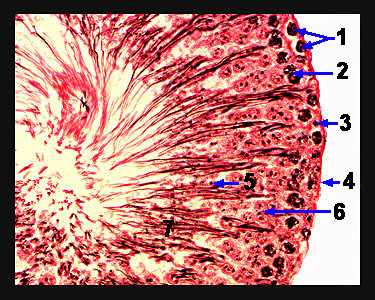|
|
||||||||||||||||||||||||||||||||||||||||||||||||||||||||||||||||||||||||||||||||||||||||||||||||||||||||||||
|
This image shows a magnified, cross-sectional view of a seminiferous tubule, which is surrounded by a thin, dark-staining basement membrane. The sperm (spermatozoa) are produced in the walls of the tubules but later appear in the lumen. The spermatogonia (2n) are the small cells occurring in one or two layers just inside the basement membrane. They are found in almost all tubules and their nuclei are usually very dark. By means of mitotic division they continue to produce additional spermatogonia. Some spermatogonia, however, do not undergo mitosis, but increase several times in size. They are then called primary spermatocytes (2n). There may be one to several layers of them located just inside the layer of spermatogonia. A young primary spermatocyte has a large nucleus with much darkly staining granular chromatin (chromosomes). |
|
